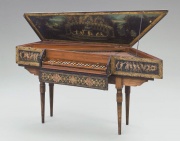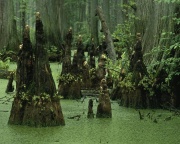Difference between revisions of "Cypress"
m (Text replace - "== Authority ==" to "== Sources Checked for Data in Record ==") |
|||
| Line 1: | Line 1: | ||
| − | [[File:1981.277-SC14526.jpg|thumb|]] | + | [[File:1981.277-SC14526.jpg|thumb|Italian virginal<br>MFA# 1981.277]] |
== Description == | == Description == | ||
| − | + | [[File:Cypress Creek National Wildlife Refuge _USFW.jpg|thumb|Cypress Creek National Wildlife Refuge]] | |
Any of several evergreen trees from the genus ''Cupressus''. Many trees from related genera, like bald cypress and some cedars, also have been commonly called cypress. True cypresses are native to the Mediterranean region (''Cupressus sempervirens'') and the Pacific coast of North America. Mediterranean cypresses, still found in Jordan, Syria, Lebanon, Turkey, Iran, Crete, and Rhodes, were used in ancient Egypt for monumental doors, furniture, boats, statuary, coffins, boxes and carving (Gale et al 2000). Cypress wood is aromatic with a smooth, close-grain, and reddish-brown color. Currently, cypress trees are often used for landscaping effects while their wood is used for general construction, storage boxes, crates, and millwork. | Any of several evergreen trees from the genus ''Cupressus''. Many trees from related genera, like bald cypress and some cedars, also have been commonly called cypress. True cypresses are native to the Mediterranean region (''Cupressus sempervirens'') and the Pacific coast of North America. Mediterranean cypresses, still found in Jordan, Syria, Lebanon, Turkey, Iran, Crete, and Rhodes, were used in ancient Egypt for monumental doors, furniture, boats, statuary, coffins, boxes and carving (Gale et al 2000). Cypress wood is aromatic with a smooth, close-grain, and reddish-brown color. Currently, cypress trees are often used for landscaping effects while their wood is used for general construction, storage boxes, crates, and millwork. | ||
| − | |||
== Synonyms and Related Terms == | == Synonyms and Related Terms == | ||
''Cupressus''; cyprès (Fr.); ciprés (Esp.); cipreste (Port.); cipresso (It.); Monterey cypress; American cypress; Mediterranean cypress | ''Cupressus''; cyprès (Fr.); ciprés (Esp.); cipreste (Port.); cipresso (It.); Monterey cypress; American cypress; Mediterranean cypress | ||
| − | == | + | ==Resources and Citations== |
| − | + | * The Wood Database: [https://www.wood-database.com/mediterranen-cypress/ Mediterranean ypress] | |
| − | |||
| − | + | * R.Gale, P.Gasson, N.Hepper, G.Killen, "Wood" in ''Ancient Egyptian Materials and Technology'', P.Nicholson, I.Shaw (eds.), Cambridge University Press, 2000, p. 334-371. | |
* ''Dictionary of Building Preservation'', Ward Bucher, ed., John Wiley & Sons, Inc., New York City, 1996 | * ''Dictionary of Building Preservation'', Ward Bucher, ed., John Wiley & Sons, Inc., New York City, 1996 | ||
Revision as of 14:24, 14 July 2022
Description
Any of several evergreen trees from the genus Cupressus. Many trees from related genera, like bald cypress and some cedars, also have been commonly called cypress. True cypresses are native to the Mediterranean region (Cupressus sempervirens) and the Pacific coast of North America. Mediterranean cypresses, still found in Jordan, Syria, Lebanon, Turkey, Iran, Crete, and Rhodes, were used in ancient Egypt for monumental doors, furniture, boats, statuary, coffins, boxes and carving (Gale et al 2000). Cypress wood is aromatic with a smooth, close-grain, and reddish-brown color. Currently, cypress trees are often used for landscaping effects while their wood is used for general construction, storage boxes, crates, and millwork.
Synonyms and Related Terms
Cupressus; cyprès (Fr.); ciprés (Esp.); cipreste (Port.); cipresso (It.); Monterey cypress; American cypress; Mediterranean cypress
Resources and Citations
- The Wood Database: Mediterranean ypress
- R.Gale, P.Gasson, N.Hepper, G.Killen, "Wood" in Ancient Egyptian Materials and Technology, P.Nicholson, I.Shaw (eds.), Cambridge University Press, 2000, p. 334-371.
- Dictionary of Building Preservation, Ward Bucher, ed., John Wiley & Sons, Inc., New York City, 1996
- Edward Reich, Carlton J. Siegler, Consumer Goods: How to Know and Use Them, American Book Company, New York City, 1937

